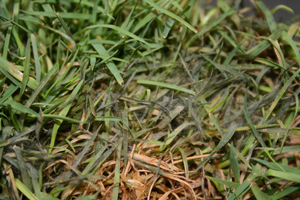G1912
Pythium Blight of Turfgrass
Causes, symptoms and management of pythium blight disease in turfgrass. This is one in a series of NebGuides on managing turfgrass diseases.
Loren J. Giesler Extension Plant Pathologist
|
Pythium blight occurs during wet weather and in high maintenance landscapes that are frequently watered. It can be managed by altering moisture availability when possible and by using fungicides. The following information describes the disease and how to identify and manage it.
Cause, Hosts and Occurrence
Cause: Pythium aphanidermatum, P. graminicola, other Pythium spp.
Primary Hosts: Perennial ryegrass, Creeping bentgrass, Annual bluegrass
Occurrence: July – August
Key Symptoms and Signs
- Roughly circular, reddish-brown spots or streaks that suddenly appear (Figure 1).
- In morning dew, infected grass leaves appear water-soaked, slimy to the touch, and dark green.
- Presence of cottonball-like mycelium in early morning.
- Affected turf may give off a fishy odor. This will be especially evident if a sample is bagged overnight.
- Commonly observed in new seedings of perennial ryegrass and annual bluegrass.
Cultural/Maintenance Practices
- Provide adequate soil drainage.
- Fill depressions where water stands.
- Thin landscape plantings to promote good air movement across the turf.
- Avoid mowing and trafficking wet turf.
- Use a balanced fertilizer program that will meet the nutritional needs of the turf but not stimulate lush growth during summer.
- Avoid overwatering and late-afternoon/early-evening watering during periods of hot, humid weather.
- Aerate to reduce thatch accumulation.
- When establishing new turf areas, do not saturate the soil on newly seeded areas, and remove mulch immediately after seedlings emerge.
Fungicide Program
- Preventive Program:
- First application in mid-June or earlier using a systemic fungicide. The first treatment should be made when the 24-hour forecast calls for favorable weather (daytime temperatures above 90°F, night time temperatures above 65°F, 80 percent or greater relative humidity).
- Second application two weeks later, also using a systemic fungicide.
- Third application of a contact fungicide should be made two weeks after the second application.
- Curative Program:
- Curative measures using contact fungicides can be used on less valuable turf areas and those less prone to Pythium blight or when blight symptoms first appear. A short spray interval of seven days may be needed under high-disease pressure.
Fungicides for Pythium blight are presented in Table I. Product examples are provided for each active ingredient, but not all products are listed. Homeowner and commercial product labels will list active ingredients. While the active ingredient may be in combination with others, users should look for a specific active ingredient with or without other chemistry modes of action.
Fungicides listed represent the best information available. Read and follow all product label directions for mixing and application.
| Table I. Fungicides for Pythium Blight Control in Turf1 | ||||
| Fungicide | Fungicide Class | Application Interval (days) |
Efficacy2 |
Product Names |
| azoxystrobin | Strobilurin | 10-14 |
2 |
Heritage |
| chloroneb | AH4 | 5-7 |
L |
Terraneb SP3 |
| copper hydroxide + mancozeb | Inorganic + dithiocarbamate | 7-14 |
L |
Junction |
| cyazofamid | QiI4 | 14-21 |
4 |
Segway |
| ethazole (=etridiazole) | Heteroaromatic | 5-10 |
1 |
Koban3 |
| fluoxastrobin | Strobilurin | 14 |
3 |
Disarm |
| fosetyl-Al | Phosphonate | 14-21 |
2+ |
Chipco Signature3 |
| mancozeb | Dithiocarbamate | 5 |
2 |
Fore3 |
| mefenoxam | PA4 | 7-21 |
3 |
Subdue MAXX3 |
| metalaxyl | PA | 7-21 |
3 |
Subdue 2E3 |
| phosphite | 14 |
2+ to 3 |
Magellan3 | |
| propamocarb | Carbamate | 7-21 |
3 |
Banol |
| pyraclostrobin | Strobilurin | 10-14 |
2+ |
Insignia |
| 1Fungicide active ingredients, class and efficacy ratings for products labeled for the control of Pythium blight. Table adapted from: P. Vincelli and A.J. Powell, Chemical Control of Turfgrass Diseases 2008, University of Kentucky Cooperative Extension Service. 2Rating system: 4 = excellent; 3 = good to excellent control; 2 = fair to good control; 1 = control is inconsistent but good in some instances; + = intermediate between two efficacy categories. 3Other products with the same active ingredient may be available. 4AH = Aromatic Hydrocarbon, QiI = Quinone Inside Inhibitor, PA = Phenylamides. |
||||
This publication has been peer reviewed.
Disclaimer Reference to commercial products or trade names is made with the understanding that no discrimination is intended of those not mentioned and no endorsement by University of Nebraska–Lincoln Extension is implied for those mentioned. |
Visit the University of Nebraska–Lincoln Extension Publications Web site for more publications.
Index: Plant Diseases
Turf
Issued February 2009
